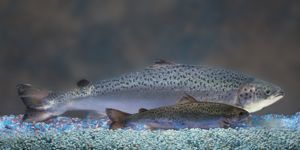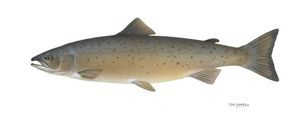FDA Puts Transgenic Fish on the Scales
Air Date: Week of November 19, 2010
 |
The first genetically modified animal for human consumption could soon be on its way to a dinner table near you. The Food and Drug Administration is set to make a decision about the safety of transgenic salmon. Some, including Dr. Martin Smith, an economist at Duke University, say the FDA is ignoring potential effects on both human and environmental health. He talks with host Bruce Gellerman.
Transcript
GELLERMAN: From the Jennifer and Ted Stanley Studios in Somerville, Massachusetts, this is Living on Earth. I’m Bruce Gellerman. The first genetically modified animal for human consumption could soon be on its way to a dinner plate near you. Any day now, the Food and Drug Administration is set to make a decision about the safety of a transgenic fish called the AquaAdvantage Salmon. It’s designed to grow about twice as fast as your usual salmon. But there are some who have a beef with the process the FDA is using to evaluate the fish. Among them is Martin Smith, an economist at Duke University.

Dr. Martin Smith, associate professor of environmental economics at Duke, is co-author of a recent paper critiquing the FDA’s review process of the first genetically modified animal for human consumption. (Duke University)
SMITH: So the concern is that the FDA is looking at this decision in an overly narrow way. They’re treating the decision about whether to approve this genetically modified salmon as if one salmon is just going to replace another salmon. But what they’re ignoring is, that with technological innovations like this, the purpose of them is to lower production costs. And, in all likelihood that will lead to expanding production, and that, in turn, may lower prices and change to total amount of salmon that people are eating.
GELLERMAN: So, the FDA is looking at this fish based upon its impact on human health and environmental safety. What are some of the larger impacts that you see?
SMITH: On the human health side, the larger impacts are quite striking. If you grow the salmon market significantly, you may have people eating more salmon and less of other animal proteins. That could have very, very significant positive public health impacts because salmon is a particularly healthy food. So, that of course, would weigh in favor of approving this product. On the negative side, if you grow the market substantially, you look at environmental impacts. One of the problems with salmon is that the technology still requires feeding salmon feed that comes from wild fish stocks. Some of those wild fish stocks are not managed well. And, so, if you grow the salmon market, you might exacerbate pressure on wild fish stocks that are poorly managed.
GELLERMAN: What about fish farmers vs. fishermen-- that is, people who raise fish in pens or people who hook them in nets or on lines?

The genetically modified AquaAdvantage salmon (background) dwarfs an Atlantic salmon of the same age. (AquaBounty)
SMITH: In this particular case, this is an interesting one, because the company plans deliberately to grow this product in tank-based systems. But, there are connections between the capture fishery for salmon and farmed salmon- the prices move together. These products don’t exist completely independently in the market. So, if you lower prices by expanding the farmed salmon market, those lower prices are going to affect fishermen.
GELLERMAN: So, what would you suggest in terms of the FDA’s process? What should they be doing?
SMITH: What we suggest is that the FDA should think about the various scenarios in which this product will affect markets. And look at those scenarios and trace through both the human health impacts, which as I mentioned could be very positive, because of the health benefits of eating salmon, but that they also look at some of these environmental consequences.
GELLERMAN: This could be an exquisitely complex problem. How do you measure society benefits vs. environmental costs, health costs, impacts down the road- how do you do that?

Jonathan Wiener, a professor at Duke Law School, co-author of the recent paper in Science. (Duke Law School)
SMITH: Well it is exquisitely complex process as you put it. In economics, we try to create a common metric for everything- so we try to monetize benefits and costs and put them together and see which ones are bigger. And, not all public policy decisions should be made solely on the basis of benefit/cost analysis, but it’s worth doing that analysis to at least inform those decisions. Even if the FDA takes the broader analysis that we suggest, they may ultimately come to the same decision about this particular case that they would looking at it narrowly. So, the issue here is process. And, we’re at a crossroads here. We have an opportunity here to set the right precedent, because we’re considering the first transgenic animal for human consumption.
GELLERMAN: I’m wondering if the FDA is institutionally capable of making this kind of decision.
SMITH: That is a very difficult question. FDA certainly has economists working for it, and so they have some capacity to do it. We argue in our paper that Congress should give them additional funding to build infrastructure to do this kind of analysis.
GELLERMAN: Oy! Then you’d have to factor in politics into your equation.
SMITH: (Laughs) I’m pretty sure politics are already involved.
GELLERMAN: Professor Smith, I’ve gotta ask you- would you eat transgenic fish?

A drawing of an Atlantic Salmon in the wild. (Drawing: Timothy Knepp)
SMITH: Uh, that’s a great question. I am working on a book called “Should I Eat Fish?” and I don’t have an answer to that question- a yes or no answer to that question, but I would lean toward yes on this particular example.
GELLERMAN: Because, you’re putting the FDA in a spot here with your paper. You’re saying, you know, ‘what do we do, what do we do, kind of, as a society?’ And, I’m standing in the supermarket thinking before the fishmonger, and I’ve gotta decide, do I eat that fish or not?
SMITH: Absolutely. I think what we do is we make decision deliberately. We weigh all the benefits and the costs. That’s what we’re asking the FDA to do- to make that as transparent as possible.
GELLERMAN: Well, Professor Smith, thank you very much!
SMITH: Thank you.
GELLERMAN: Martin Smith is an economist at Duke University. His analysis of the FDA review process of the first transgenic fish appears in the latest issue of Science.
[MUSIC: Marco Benevento “Numbers” from Between The Needles And Nightfall (Royal Potato Family 2010)]
Links
Living on Earth wants to hear from you!
Living on Earth
62 Calef Highway, Suite 212
Lee, NH 03861
Telephone: 617-287-4121
E-mail: comments@loe.org
Newsletter [Click here]
Donate to Living on Earth!
Living on Earth is an independent media program and relies entirely on contributions from listeners and institutions supporting public service. Please donate now to preserve an independent environmental voice.
NewsletterLiving on Earth offers a weekly delivery of the show's rundown to your mailbox. Sign up for our newsletter today!
 Sailors For The Sea: Be the change you want to sea.
Sailors For The Sea: Be the change you want to sea.
 The Grantham Foundation for the Protection of the Environment: Committed to protecting and improving the health of the global environment.
The Grantham Foundation for the Protection of the Environment: Committed to protecting and improving the health of the global environment.
 Contribute to Living on Earth and receive, as our gift to you, an archival print of one of Mark Seth Lender's extraordinary wildlife photographs. Follow the link to see Mark's current collection of photographs.
Contribute to Living on Earth and receive, as our gift to you, an archival print of one of Mark Seth Lender's extraordinary wildlife photographs. Follow the link to see Mark's current collection of photographs.
 Buy a signed copy of Mark Seth Lender's book Smeagull the Seagull & support Living on Earth
Buy a signed copy of Mark Seth Lender's book Smeagull the Seagull & support Living on Earth

